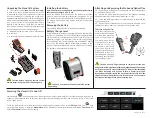
Brunata Optuna H
UK-QB101575/29.05.2012
Installation Guide
Pages 7/16
Brunata a/s · Vesterlundvej 14 · 2730 Herlev · tlf. +45 77 77 70 00 · fax +45 77 77 70 01 · [email protected] · www.brunata.dk
3.0 Power supply
3.1 Battery
A 3.6 V DC lithium battery is fitted in the standard version. The battery is not to be charged or short-circuited. Ambient
temperatures below 40 °C extend the life of the battery. Used batteries must be disposed of at suitable waste
collection points!
Caution:
Risk of explosion if battery is replaced by an incorrect type.
3.2 Mains unit
24 V AC or 230 V AC mains units (Protection Class 1) can be changed or retrofitted at any time. The protective safety
cover must be installed at all times. Never connect between two phases, as this would destroy the mains unit. The
cable is to be fused at max. 6 A and protected against manipulation.
The mains unit notifies the meter if mains voltage is present. If the mains fail, the backup battery (CR2032) in the
mains unit provides the power supply for up to one year. The LCD readings (on pressing button) and the date and time
are still updated, but none of the measuring functions work, incl. the flow rate measurement. Communication still
functions over the optional M-Bus, RS485 and RS232 modules or the optical interface, but reduces the life of the
backup battery. The radio function is switched off in the event of mains failure.
4.0 Extension modules
The energy meter has two slots for extension modules.
Slot 1
Slot 2
- Pulse In (2x)
- Pulse In (2x)/Out (1x)
- RS232
- M-Bus
- RS485
- L-BUS (for ext. radio)
- Analogue Out (2x)
- Pulse In (2x)
- Pulse Out (2x)
- Pulse In (2x)/Out (1x)
- RS232
- M-Bus
- RS485
- L-BUS (for ext. radio)
The modules can be used and combined as shown in the above table. Use of combinations not
included in the above table is not allowed. With radio meters the slot 2 of the communication
modules has to be left empty. These modules have no effect on consumption recording and can be
fitted retrospectively without damaging the verification mark. The relevant ESD regulations
(electrostatic discharge) must be observed. No liability is accepted for damage (especially to electronic circuits)
resulting from failure to comply with the ESD regulations.


































